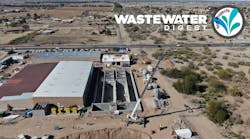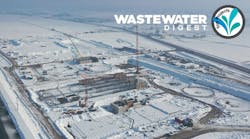Cost: $760,000
Location: Celaya, Guanajuato, Mexico
Year: 2010-12-01
Size: 475 gpm
Owner: Junta Municipal de Agua potable y Alcantarillado de Celaya
Designers: Aquatec Internacional SA de CV
Contractor: Aquatec Internacional SA de CV; Calidad Construccion y Diseno
In many parts of the world, including Mexico, Bangladesh and Peru, arsenic contamination is one of the most malevolent signs of poverty and hardship. The case is certainly no different for a neighborhood in Celaya, Guanajuato, a city in central Mexico. The city gets its potable water from a deep well and suffers from arsenic concentration levels of 60 parts per billion (ppb). (The Mexican standard is 25 ppb, and the World Health Organization [WHO] standard is 10 ppb.) The city’s well is owned and operated by local water company Junta Municipal de Agua potable y Alcantarillado (JUMAPA).
Fortunately, change is happening.
“The city gave us the terrain to built a plant, but when we began to do exploration to make the foundation, we found that there was a landfill in the past that nobody knew about,” said Oscar Quinones, manager with Aquatec Internacional SA de CV. “Then we began excavation during August and September and we removed all the garbage in the soil and we put in good soil to do the foundation; and this is important ... Arsenic is worse when you have poor people, children, old people. That was the case for this community where the plant will be ... It’s amazing what we are finding,” Quinones said.
During the predesign stages, several restrictions were established by the local water company. Technologies like coagulation-sedimentation were not possible. The water company restricted reverse osmosis and other alternatives as possible treatment. Flow of 475 gal per minute restricted the application for some media filtration and for domestic-size devices. With hardness content about 200 ppm calcium carbonate, silica about 70 mg/L and some total suspended solids present, some media filtration could not work.
Thus, JUMAPA selected Aquatec Internacional to design, build and operate the new system to remove arsenic using the proposed technology of coagulation-ultrafiltration (UF). It not only overcame the related challenges but also exceeded some of the restrictions by, for instance, demonstrating results of less than 8 ppm arsenic in trials.
Quinones noted the significance of this project for Dow Chemical Co., manufacturer of the ultrafiltration modules used on this project: “They have a media—some particles of titanium dioxide—to remove arsenic. It’s the first time Dow will have UF modules to remove arsenic.”
The plant has an expected completion date of Jan. 15, 2011.
Project Year: 2010-12-01
Contractor: Aquatec Internacional SA de CV; Calidad Construccion y Diseno
Designers: Aquatec Internacional SA de CV
Owner: Junta Municipal de Agua potable y Alcantarillado de Celaya
Location: Celaya, Guanajuato, Mexico
Cost: $760,000
Size: 475 gpm

